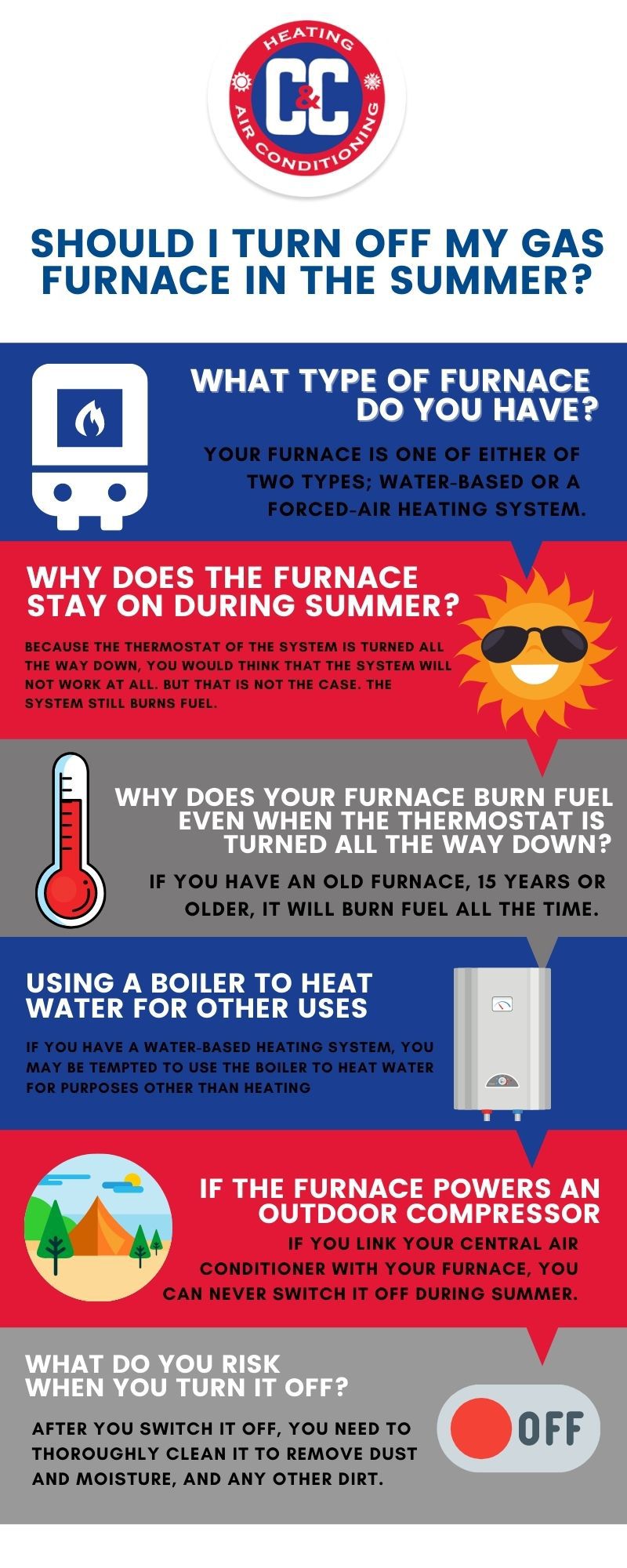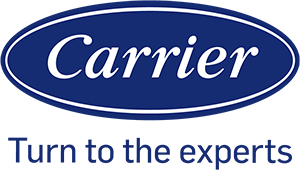C & C Heating: Your summer heating and cooling questions are answered!
The sight of blooming flowers marks the end of the cold season in Michigan and ushers in spring and summer. Although all you may be thinking about is a summer vacation, you must consider what to do with your gas furnace. Though switching it off seems like the best idea since it will mean lower utility bills, is it truly the best idea?
In this blog, our heating technicians explain the basics of how a furnace works and outline the benefits of turning it off or leaving it on during the summer. We will also provide a step-by-step guide on how to turn the furnace switch to the off position safely. Read on to learn the best course of action you should take during the summer.
What Type of Furnace Do I Have?
Two factors will decide whether your furnace stays on or is switched to the off position during the summer. These factors include whether you have a forced-air vs. water-based heating system and whether your furnace is an older or a more modern model.
Forced Air Heating Systems
Forced-air heating systems disperse heat in the form of warm air through floor and wall vents. This system needs a furnace and is the most common system for homes.
Water Based Heating System
Water-based systems transport heat to your home as water or steam through a radiator, radiant floor heating, or a baseboard heater. These systems need a boiler, which is often referred to as a hydronic system.
Both systems get power from combusted gas. The thermostat setting determines the system’s output. Most homeowners think the gas furnace is off during summer because the thermostat is turned down. However, as long as the pilot light is on, the furnace consumes energy.
Traditional Gas Furnace (Older Models)
If you have a traditional gas furnace, its pilot light stays on every day of the year, even when the furnace is not in use.
Modern Furnace Models
You may not have to deal with the pilot light problem if you have a newer furnace that runs on electricity.
Is the Furnace Ever Fully Off?
Your furnace doesn’t go off all the way, even during the hot summer months. However, you will likely turn the switch of the furnace all the way down to the off position. Because the system’s thermostat is turned down, it is easy to assume that it is entirely off. However, it is still burning fuel, especially if you have an older model. Even electric furnaces will draw some energy to be “ready” to receive commands from the thermostat to ignite.
The only time the furnace is turned off is when it goes through a manual shutdown procedure, which typically involves turning off the gas valve or extinguishing the pilot light to stop gas usage. We outline how to do this in a step-by-step guide below, but first, we want you to consider all the benefits of keeping the furnace on versus turning it off during the summer.
Reasons to Keep the Furnace On Throughout the Summer
Before you decide to shut off your furnace for the summer months, please consider the reasons for keeping it on. While the decision is up to you, we want to ensure that you get the whole perspective before doing so.
- Avoid the Hassle of Relighting the Pilot Light
- No Need to Reprogram or Reset the Thermostat
- Used Share of Blower Motor with Air Conditioning
- Minimal Energy Use in Modern Furnaces
- Be Ready for Unexpected Temperature Drops
- Potential Safety Benefits
- Cost Considerations
Relighting pilot lights is a hassle. This process is especially tedious in older units, creating frustration while taking you away from other preparatory tasks you have to accomplish before fall. Plus, you have to know what you’re doing when lighting the pilot light.
Still, many homeowners consider shutting off the furnace to save on energy costs. In newer models, the energy consumption is so low that the benefits of leaving the heating light switch on outweigh the minor cost savings.

What Do You Risk When You Turn It Off?
Turning off your gas furnace in the summer may cause you to risk losing sight of its required maintenance and faster deterioration as a result, If you turn off your system, you need to ensure that you sustain routine maintenance.
- After you switch off the furnace, clean it to remove dust, moisture, and all other dirt.
- If your basement gets damp in summer, then water might gather on your furnace and likely cause rusting. Make sure the area around the furnace is properly ventilated to prevent this problem.
- Soot on the furnace can also cause corrosion, which further shortens the productive life of your furnace. Make sure that there is a quality furnace filter installed on the unit to prevent this from occurring.
- Clean the unit regularly to prevent soot, dust, and debris buildup.
If you still choose to keep the system off, you can schedule regular maintenance services with an air conditioner technician at C&C Heating.
Steps to Turn the Furnace Switch Off
If you still feel that turning off the gas furnace is the best course of action for your home, we provide a simple, step-by-step guide. If you are uncomfortable with any step of this procedure, we urge you to contact an HVAC professional for help.
1. Turn off the Thermostat
Begin by switching the thermostat to the “off” setting to ensure that the heating mode is in the off position. Then, adjust the thermostat settings for air conditioning if needed.
2. Shut Off the Gas Supply
Find the gas valve connected to your furnace and shut it off. This gas valve is usually found near the stove, along the gas line, or on the control panel. It will look like a small lever or a knob.
Once you find the lever or knob, turn it so that it is perpendicular to the gas line. This will shut off the gas supply to the gas furnace, preventing any gas usage during the summer.
3. Extinguish the Pilot Light (If you have an older furnace)
If you’re using an older gas furnace model, you must extinguish the pilot light near the burner. Turn the control for the pilot light off and wait for it to cool entirely before moving on to the next step.
4. Turn Off the Furnace Power
As an optional step, you can cut the electrical power to the furnace to ensure that it is fully deactivated. Find the power switch on or near the furnace and switch it off. You can also turn off the switch at the circuit breaker to ensure that the furnace is always off.
5. Schedule Gas Furnace Maintenance
Once your furnace is entirely off, make sure to schedule a furnace maintenance service with your local heating technician. This service usually includes checking the furnace filter, an inspection of the vents and ducts, and other essential components such as the blower motor and pilot lights. This inspection will allow your HVAC technician to find any opportunities for repairs and adjustments, ensuring it is ready to operate efficiently in the fall.
How Does a Gas Furnace Work?
Gas furnaces provide the comfort and warmth needed during the heating season. This vital part of the HVAC system consists of multiple mechanical parts that work together to ensure that you have heat in your house all winter long.
- Burner: The part that burns natural gas or propane to create heat.
- Heat Exchanger: Where the heat is transferred from the gases created in the combustion chamber to the air circulated throughout the home.
- Blower Motor: This motor is in charge of pushing warm air through the ducts into the living spaces.
- Thermostat: Controls when the furnace has to run on and off based on the temperature inside the house.
- Pilot Light or Electronic Ignition: Ignited the gas in the burner to create heat.
- Flue or Vent Pipe: Transfers combustion gases outside the home safely.
How the Furnace Works to Keep You Warm During the Heating Season
The furnace works in five key stages to ensure that your home is warm and cozy all winter long. This heating system is perfectly designed to execute each function of heating in a safe and energy-efficient way in the following five steps:
1. Thermostat Activation
Any HVAC system, including the furnace, will only begin its operation when it is sent a signal from the thermostat. When the thermostat senses that the temperature is below or above the preset temperature, it will make the HVAC system spring into action to create those preferred temperatures.
2. Pilot Light Ignition
Both electric and gas furnaces use a pilot light that ignites at the burner. The initial spark that occurs at the ignition helps the entire heating system spring into action, responding to the signals of the thermostat.
3. Heat Generation
Once the pilot light ignites the burner, it sets off to generate the heat required to create that cozy atmosphere inside the home. The heat passes through the heat exchanger, where combustion gases are eliminated.
4. Warm Air Distribution
Once the combustion gases are eliminated, warm air is pushed into the ductwork by a blower motor and distributed throughout the home.
5. Ventilation of Exhaust Gases
As the warm air is distributed throughout the home, combustion gases are sent outside using a special gas valve called the flue. This is essential to keeping the safety standards of the indoor space at the highest level.
CONTACT HVAC SYSTEM TECHS AT C & C HEATING & AIR CONDITIONING
At C & C Heating & Air Conditioning, we service your home’s heating, air conditioner, air filtration, humidification, and dehumidification systems in Roseville, MI. Our team of technicians is experienced in the installation, repair, and maintenance of these systems. If your HVAC system needs replacing, we offer HVAC equipment from top manufacturers Trane, Carrier, and Lennox. You can also get financing as one of our new or repeat customers.
Contact C & C Heating & Air Conditioning and speak to a professional about your heating and air conditioning needs.





